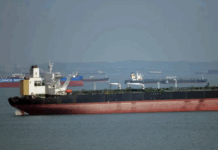This year is a crucial year for Papua New Guinea’s mining industry as important players – in Hela, Porgera and Madang – are being examined over their performance. Video: EMTV
COMMENTARY: By Scott Waide in Lae
Just into the fourth month of 2019, and resource projects in Papua New Guinea have come under scrutiny.
Early last month, senior ministers of government, including Petroleum Minister Fabian Pok, traveled to Komo in Hela for meetings with landowners of the gas project.
After 15 years, there is some progress. Or at least that’s the positive spin to it.
READ MORE: O’Neill loses in high stakes battle for control of US$1.4b PNGSDP
There appears to be some indication that royalties locked away due to legal battles and tangled by bureaucratic red tape were going to be paid – but only after landowner identification processes.
Finance Minister James Marape told the media three months ago, that K300 million (NZ$132 million) is parked at the Central Bank ready to be released. But landowners or people claiming to be landowners had to follow a process of “landowner identification” in order to be paid the money.
There is some hope of an end to disputes. However, the final settlement is still a long way off. That’s the reality. Many of the elders died waiting for the royalty payments they were promised.
Since becoming a new province, there is still a lot that needs to be ironed out. The Hela provincial government still has to work its way through layers of bureaucratic processes that continue to favour the Southern Highlands in terms of royalty payments from the gas project.
It’s all that and a lot more.
Background to complexities
Understanding the background to the complexities of the resource project in Hela means going back some 20 years when oil extraction ended and the promise of Papua New Guinea becoming the Saudi Arabia and Dubai of the Pacific faded as the crude oil taps shut off.
It is against that backdrop that the neighbouring Enga province is now looking at the Porgera mine’s renegotiation through a wardens’ hearing. This is a process that is reopened after the end of a mining lease.
Landowners and the Enga provincial government are looking at a bigger slice of revenues and benefits.
What did they get over the last 30 years? That’s a point of contention for pro-mining and anti-mining proponents.
What is visible to the international community is the campaigns against alleged atrocities committed against local people in Porgera and the desperate push by locals to get what little crumbs they can from a mine that has existed for 30 years on their land.
For the first time in more than three decades, it appears the national government is speaking a different language: One that calls for greater benefits into government coffers and landowner pockets.
This rhetoric has come after 30 years of gold extraction, 500 shipments of liquefied natural gas and billions of dollars worth of round log exports.
Production-based tax
In Lae, during the opening of the Central Bank’s Currency Processing Facility, Deputy Prime Minister Charles Abel talked about a production-based tax. Instead of a profit-based tax for resource projects which will be signed from 2019 onwards.
The general thinking from the national government is that a profits based tax can be deceptive leaving the government with very little to collect if a mining company declares losses or breaks even.
While Porgera discusses mine benefits, a similar process is happening in Madang. Triggered by an agreement between the Chinese and the PNG Governments, Ramu Nickel’s expansion is in discussions ongoing between the government and the developer.
The processes are long and drawn out. The risk is that without proper representation, landowners could be left with another raw deal for several more decades before another opportunity for renegotiation presents itself.
Scott Waide’s blog columns are frequently published by Asia Pacific Report with permission. He is also EMTV deputy news editor based in Lae.













































